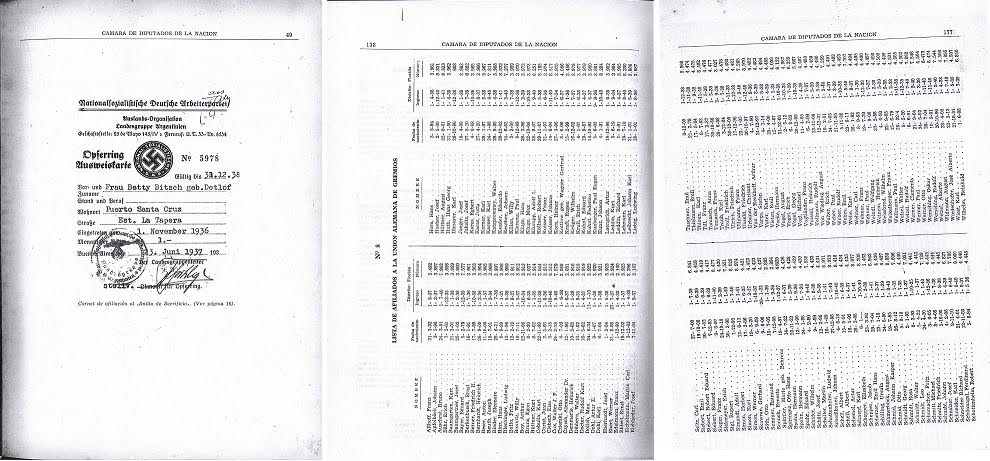“We believe that these long dormant accounts hold monies looted from Jewish victims.”
Paris and Buenos Aires, 2 March 2020
Argentine investigator, Pedro Filipuzzi, has shared with Dr. Shimon Samuels and Dr. Ariel Gelblung - respectively the Centre’s Director for International Relations and Director for Latin America - a list of some 12,000 names of Nazis in Argentina, many of whom had contributed to one or more bank accounts at the Schweitzerische Kreditanstalt, which became the Credit Suisse bank, based in Zurich, Switzerland.
During the 1930s, the pro-Nazi military regime of President José Félix Uriburu, who was nicknamed “Von Pepe” as a Germanophile, and of his successor Agustín Pedro Justo, welcomed a growing Nazi presence in Argentina.
In 1938, the latter was replaced by anti-Nazi President Roberto Ortiz, who established the “Special Commission to Research Anti-Argentine Activities,” principally to de-Nazify Argentina.
Up until 1938, however, there was an official figure of 1,400 members of the NSDAP/AO (the German National Socialist Party / Foreign Organization), based in Argentina, with 12,000 supporting members of the cover-up “Unión Alemana de Gremios” (the German Union of Syndicates) formerly named "Frente Aleman del Trabajo" (German Labour Front) and an additional 8,000 affiliated to other Nazi organizations.
“These included such German companies as IG Farben (the supplier of Zyklon-B gas, used to exterminate Jews and other victims of Nazism) and financial bodies such as the 'Banco Alemán Transatlántico' and the 'Banco Germánico de América del Sur.' These two banks apparently served for Nazi transfers on the way to Switzerland,” explained Samuels.
Gelblung added, “Many of the names listed were related to pro-Nazi companies blacklisted by the US and UK during World War Two.”
The aforementioned Special Commission to Research Anti-Argentine Activities captured the complete cache of documents in a raid on the Unión Alemana de Gremios. In the period 1941-1943, the Cámara de Diputados de la Nación (the lower chamber of the Congress) studied and printed a report that included Nazi bank transfers from Argentina to Switzerland. We hold a copy of the list of Nazis based in Argentina, among whom several account holders of funds that were sent to the then Schweizerische Kreditanstalt, now Credit Suisse.
In 1943, the pro-Nazi United Officers' Group (in Spanish, GOU - Grupo de Oficiales Unidos) took power - headed by fascist militia leader Pedro Pablo Ramirez Menchaca as President - and disbanded the Special Commission, burning their findings and reports, including the Nazi-related lists printed by the Cámara de Diputados de la Nación.
Mr. Filipuzzi, working in the former Buenos Aires Nazi headquarters, discovered, in an old storage room, an original copy of the 12,000 list, now shared with the Wiesenthal Centre. See below selected pages of the file:

Examples of the Cámara de Diputados de la Nación’s materials found by our researcher.
In a letter to Credit Suisse Vice-President, Christian Küng, the Centre stated: “We believe very probable that these dormant accounts hold monies looted from Jewish victims, under the Nuremberg Aryanization laws of the 1930s,” adding, “We are aware that you already have claimants as alleged heirs of Nazis in the list.”
The Centre requested access to the Credit Suisse archives to settle this matter on behalf of the diminishing number of Holocaust survivors.
“Mr. Küng, in 1997, we organized a major conference in Geneva, together with Winterthur Insurance, on ‘Restitution: A Moral Debt to History’. A few weeks before our conference, I received a telephone call from Credit Suisse, requesting to co-sponsor our gathering.”... “In the spirit of the conference’s title, I asked for access to spoliated accounts for our expert researcher. There was no response,” noted Samuels.
“The current story and the remaining assets, arguably looted, of 12,000 Nazis will, we hope, be viewed differently, for the good name of Credit Suisse,” concluded Samuels and Gelblung.
